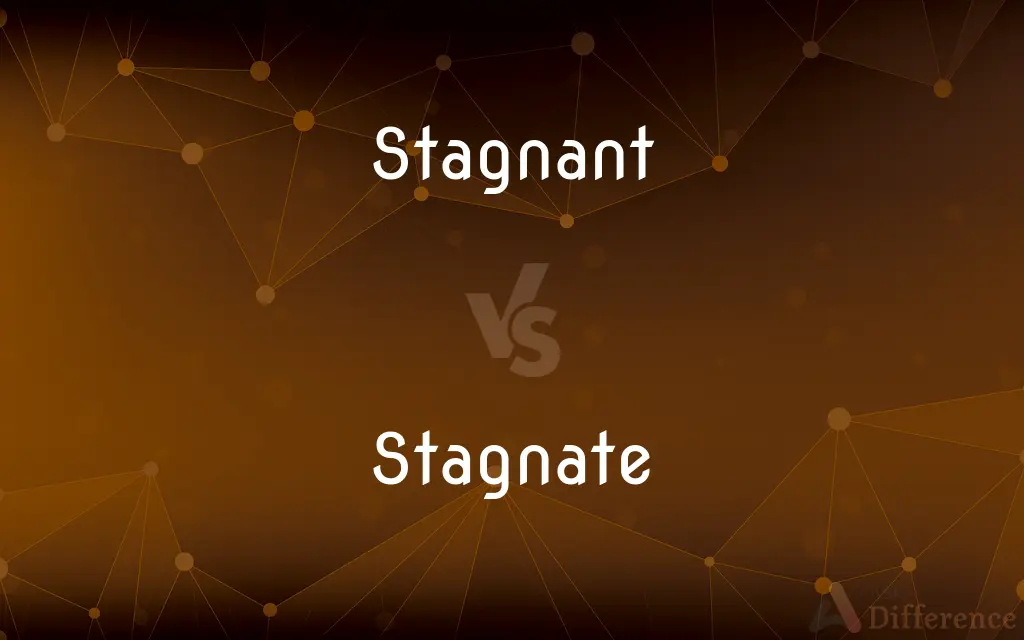Stagnant vs. Stagnate — What's the Difference?
Edited by Tayyaba Rehman — By Maham Liaqat — Updated on March 28, 2024
Stagnant describes water or air that is not flowing or moving, implying a lack of activity or progress, while stagnate refers to the process of becoming stagnant, often used metaphorically for lack of growth.

Difference Between Stagnant and Stagnate
Table of Contents
ADVERTISEMENT
Key Differences
Stagnant is an adjective used to describe something, typically water or air, that is not flowing or moving, and can also metaphorically describe situations, projects, or economies that are not experiencing growth or progress. On the other hand, stagnate, a verb, refers to the process of becoming stagnant, indicating a transition or change from a state of movement or growth to one of inactivity or lack of progress.
When water becomes stagnant, it loses its freshness and can become a breeding ground for bacteria and pests. This physical condition serves as a powerful metaphor for projects or initiatives that are not moving forward, where ideas and efforts are not evolving or improving. In contrast, to stagnate suggests an action or process where something that was previously dynamic or growing begins to slow down and eventually stops progressing, leading to a state of stagnation.
In business, a stagnant market is one where there is little to no growth, customer interest remains flat, and innovative developments are scarce. This situation can lead to reduced profits and a lack of competitive advantage. Meanwhile, a company begins to stagnate when its growth slows down significantly due to factors such as lack of innovation, poor management, or external economic conditions, eventually leading to a stagnant state if not addressed.
Environmental conditions can also be described as stagnant, for example, when air pollution remains constant due to lack of wind or natural air flow, leading to health hazards. The process of an environment beginning to stagnate involves a reduction in natural or artificial forces that would otherwise refresh or renew the air or water, highlighting the dynamic nature of stagnation as a process.
Stagnation, whether describing water, air, or metaphorical situations, implies a need for intervention or change to reintroduce movement, growth, or flow. The transition from a dynamic state to a stagnant one, as captured by the verb stagnate, underscores the importance of continuous effort and innovation to prevent decline.
ADVERTISEMENT
Comparison Chart
Part of Speech
Adjective
Verb
Definition
Describes something not flowing or moving; lacking growth or progress.
Refers to the process of becoming stagnant or ceasing to flow or move.
Usage Context
Used to describe conditions or situations.
Used to describe the action or process leading to stagnation.
Example Scenario
Stagnant water in a pond; a stagnant economy.
A pond begins to stagnate; an economy starts to stagnate.
Implications
Implies a current state of inactivity or lack of progress.
Suggests a transition into a state of inactivity or lack of progress.
Compare with Definitions
Stagnant
Water not flowing in a pond.
The stagnant pond attracted mosquitoes.
Stagnate
When water stops flowing.
The river began to stagnate during the drought.
Stagnant
Air that does not circulate.
The room felt hot and stagnant.
Stagnate
When air circulation halts.
Without windows, the air in the room stagnates.
Stagnant
A market with no growth.
The tech sector is currently stagnant.
Stagnate
When economic growth halts.
The economy will stagnate without investment.
Stagnant
A lack of new ideas or creativity.
The writer's imagination had become stagnant.
Stagnate
When creativity or innovation ceases.
Without fresh ideas, the team's work stagnated.
Stagnant
Unchanging, dull routines.
My job feels stagnant and unfulfilling.
Stagnate
When progress on a project ceases.
The project stagnated due to lack of funding.
Stagnant
Not flowing or moving, and often foul-smelling or stale
Stagnant ponds.
Stagnant air.
Stagnate
To be or become stagnant.
Stagnant
Showing little or no activity or vitality; inactive or sluggish
A stagnant economy.
A stagnant mind.
Stagnate
To cease motion, activity, or progress:
Stagnant
Lacking freshness, motion, or flow; decaying through stillness.
A stagnant pool
Stagnant water
Stagnate
(of water, air, etc) To cease to flow or run.
If the water stagnates, algae will grow.
Stagnant
(figurative) Without progress or change; stale; inactive.
A stagnant economy
Stagnant prices
Their love had turned stagnant
Stagnate
(of water, air, etc) To be or become foul from standing.
Air stagnates in a closed room.
Stagnant
Not active or brisk; dull; as, business is stagnant.
That gloomy slumber of the stagnant soul.
For him a stagnant life was not worth living.
Stagnate
To cease to develop, advance, or change; to become idle.
Stagnant
Not growing or changing; without force or vitality
Stagnate
To cease to be brisk or active; to become dull or inactive; as, commerce stagnates; business stagnates.
Ready-witted tenderness . . . never stagnates in vain lamentations while there is any room for hope.
Stagnate
Stagnant.
Stagnate
Stand still;
Industry will stagnate if we do not stimulate our economy
Stagnate
Cause to stagnate;
There are marshes that stagnate the waters
Stagnate
Be idle; exist in a changeless situation;
The old man sat and stagnated on his porch
He slugged in bed all morning
Common Curiosities
How can an economy stagnate?
An economy can stagnate when there is no growth, often due to lack of investment, innovation, or consumer spending.
How can one prevent stagnation?
Preventing stagnation involves introducing changes, encouraging innovation, and maintaining momentum in activities or projects.
What does it mean for water to be stagnant?
Stagnant water is water that is not flowing or moving, often leading to a buildup of bacteria and unpleasant odors.
What measures can counteract economic stagnation?
Countermeasures include stimulating investments, encouraging consumer spending, and implementing policies that support innovation.
Can a stagnant market recover?
Yes, with the right strategies and conditions, a stagnant market can recover and show growth.
What are signs of a stagnating career?
Signs include lack of advancement opportunities, feeling unchallenged, and no increase in responsibilities or learning.
Is stagnant always negative?
While often used negatively to imply lack of progress, "stagnant" can be neutral when describing natural states, like stagnant water in a specific habitat.
Can personal growth stagnate?
Yes, personal growth can stagnate if individuals do not seek new experiences, learn new skills, or challenge themselves.
Why is stagnant air a concern?
Stagnant air can lead to poor air quality, health issues, and discomfort due to lack of fresh air circulation.
What can cause a project to stagnate?
Projects can stagnate due to factors like lack of resources, direction, or motivation among team members.
What strategies can businesses use to avoid stagnating?
Strategies include diversifying offerings, investing in research and development, and staying responsive to market trends and consumer needs.
Can stagnation affect mental health?
Yes, stagnation in personal or professional life can lead to feelings of dissatisfaction, impacting mental health.
What is the impact of stagnation on innovation?
Stagnation can significantly hinder innovation by reducing the incentive to develop new ideas or products.
How does technology influence stagnation?
Technology can both contribute to and alleviate stagnation, depending on how it's applied in promoting efficiency and innovation.
What role does leadership play in preventing stagnation?
Effective leadership is crucial in preventing stagnation by setting clear goals, motivating teams, and fostering an environment of continuous improvement.
Share Your Discovery

Previous Comparison
Could vs. Should
Next Comparison
Suedehead vs. SkinheadAuthor Spotlight
Written by
Maham LiaqatEdited by
Tayyaba RehmanTayyaba Rehman is a distinguished writer, currently serving as a primary contributor to askdifference.com. As a researcher in semantics and etymology, Tayyaba's passion for the complexity of languages and their distinctions has found a perfect home on the platform. Tayyaba delves into the intricacies of language, distinguishing between commonly confused words and phrases, thereby providing clarity for readers worldwide.
















































